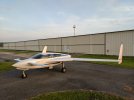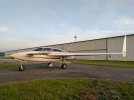Let'sgoflying!
Touchdown! Greaser!
If it’s possible to narrow down the radio that any particular antenna is attached to solely using its external appearance, perhaps there is an illustrated compendium a student pilot could refer to?
The blades would probably be DME and transponder antennas. The "wire" may be ADF.how about these
2 blades, one ‘wire’
I always thought those types of questions were idiotic. Makes as much sense as requiring drivers license applicants to be able to identify the logos of all car manufactures.I remember being quizzed on this by the dpe on my private checkride. There are some goofy vor antennas. Mine looks like they borrowed the hand towel holder out Bill Piper's bathroom.
It’s trivia that takes bandwidth from students who need it for flying, navigation skills and other things that actually need to be immediately recalled. Is there any situation in which a pilot needs to identify the type of antenna and he can’t take the time to look it up? Same kind of BS as TOMATO FLAMES or knowing tire pressures from memory.I always thought those types of questions were idiotic. Makes as much sense as requiring drivers license applicants to be able to identify the logos of all car manufactures.
I don't disagree. To play devil's advocate, you have to know where the antennas are to preflight them, and their purpose dictates their placement.I always thought those types of questions were idiotic. Makes as much sense as requiring drivers license applicants to be able to identify the logos of all car manufactures.
First of all, the only thing a typical pilot can do to preflight an antenna is to make sure it's firmly attached. You don't need to know what the antenna does in order to do that. As for where an antenna is, I would submit that if you can't see an external antenna then you probably failed the vision test and shouldn't be flying.I don't disagree. To play devil's advocate, you have to know where the antennas are to preflight them, and their purpose dictates their placement.



I always thought those types of questions were idiotic. Makes as much sense as requiring drivers license applicants to be able to identify the logos of all car manufactures.
I always thought those types of questions were idiotic. Makes as much sense as requiring drivers license applicants to be able to identify the logos of all car manufactures.
It’s trivia that takes bandwidth from students who need it for flying, navigation skills and other things that actually need to be immediately recalled. Is there any situation in which a pilot needs to identify the type of antenna and he can’t take the time to look it up? Same kind of BS as TOMATO FLAMES or knowing tire pressures from memory.
That reminds me, is it helpful, in the task of identifying antennae to disconnect the bnc connector that some have, then see which radio fails/underperforms?
Or does removing the load have the potential to damage the radio?
Also, the possibility of damaging an older transmitter could be eliminated by connecting a dummy load.You can always disconnect the antenna of something that's receiving without causing harm. Some transmitters, more likely older ones, can be harmed by transmitting without an antenna, and I wouldn't do it on purpose with anything. So I wouldn't disconnect a transponder antenna without knowing if it was harmless to do so. Com or nav radio as long as you don't key it, or GPS or ADF? Sure.
Well, I think my #2 photo above is an ADF antenna, but I still have no clue about #1.
Could you provide more details on the oscilloscope method? Eg., should both ends of the loop go to the + probe end, or one end to the + probe and the other to the ground clip. How many loops in the coil? Coil diameter? Other? ThanksOr, if you have an oscilloscope, you can make a sniffer by putting a small loop of wire on the tip of a scope probe and holding it near each antenna while transmitting. The scope trace will show a large magnitude increase when the sniffer is next to the hot antenna.
Could you provide more details on the oscilloscope method? Eg., should both ends of the loop go to the + probe end, or one end to the + probe and the other to the ground clip. How many loops in the coil? Coil diameter? Other? Thanks
Thank-you. And my apologies to the others for taking the thread on a tangent.Real simple. You're not looking for an accurate measurement, just the presence of RF. Just make a loop of wire an inch or so in diameter and clip both ends to the probe tip. Don't worry about the ground wire. The RF will induce enough noise to see on the scope. You can experiment with the loop diameter a bit.
This is just a crude version of a commercial probe like this: https://www.testequity.com/product/...WiRPH_JnLJKP_xtQxMzlmsaPEvEb5AfBoCmzsQAvD_BwE
Commercial probes have shielding and are calibrated and band-limited and some have built-in preamps, but for just figuring out which antenna is emitting RF you don't really need those nuances. We used to do this when we were troubleshooting EMI emissions on missiles and needed to see where the RF leak was.
If you're interested here's a little light reading on the subject: https://www.unitest.com/pdf/ee_0287_berger.pdf .
I did the oscilloscope test today and it worked to identify the antennas. My plane has an antenna switchbox in the coax from Com2. It switches out the Com2 radio and connects a handheld to the Com2 antenna when a coax from the handheld's antenna connection is plugged into the switchbox jack. With a portable oscilloscope on the ground near the lower VHF antenna and the wire coil held near the antenna tip, keying the radio produced a strong signal on the scope (in auto mode). Moving the oscilloscope and wire coil to the top of the plane near the top VHF antenna produced a much weaker signal when the handheld was keyed. Moving the oscilloscope coil from the top to the bottom while the handheld was transmitting resulted in a continuous increase in signal intensity as the coil was moved closer to the bottom antenna. So the top antenna must be Com1 and the bottom antenna Com2.

